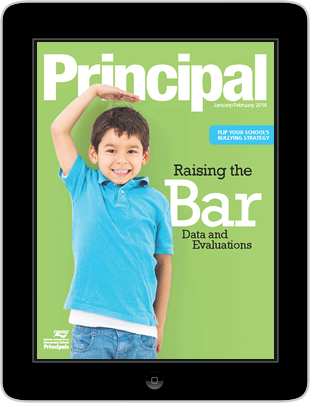Principal Is Now Digital
Communicator February 2014, Volume 37, Issue 6
Communicator
February 2014, Volume 37, Issue 6
 In case you missed it, Principal now has a digital edition. It provides an interactive, mobile reading experience for members. The new format lets readers easily navigate from article to article, access links to great Web resources, print PDFs, and search the issue. The January/February 2014 issue explores data and evaluations, focusing on how principcals can bring data pieces together for positive outcomes.
In case you missed it, Principal now has a digital edition. It provides an interactive, mobile reading experience for members. The new format lets readers easily navigate from article to article, access links to great Web resources, print PDFs, and search the issue. The January/February 2014 issue explores data and evaluations, focusing on how principcals can bring data pieces together for positive outcomes.
Catch up on these past digital issues:
- November/December 2013: Safe & Positive School Culture
Students today need every possible advantage to navigate the increased expectations of their ever-complicated worlds. A safe school with a positive culture gives them that advantage, helping them focus on achieving their fullest potential. Because culture permeates every aspect of a school—from teaching and learning conditions to collaboration to attendance to security—a principal’s ability to maintain a positive environment can improve learning outcomes. This issue explores how principals can create positive school cultures, and how they can ensure that the schools they lead are physically and emotionally safe places to learn.
- September/October 2013: Early Learning
This issue of Principal is all about early learning, exploring structures principals can use to help develop an effective continuum of learning for pre-K-3 students. Taken together, these articles will help you consider the effect of both an aligned early learning curriculum and more significant arts integration on your own student population, especially for children at risk for underachievement.
- May/June 2013: The Achievement Gap
This issue of Principal investigates the school’s role in leveling the playing field. It starts with Christopher Wooleyhand’s six-step framework for what principals can do to close the gap, including instilling a schoolwide culture of efficacy. The Q&A with University of Maryland, Baltimore County President Freeman Hrabowski provides a 30,000 foot view discussion of strategies to bridge the achievement gap. In addition, this issue features the last article in the five-part series for early career principals, Charting Your Path.
—
Copyright © 2014. National Association of Elementary School Principals. No part of the articles in NAESP magazines, newsletters, or website may be reproduced in any medium without the permission of the National Association of Elementary School Principals. For more information, view NAESP’s reprint policy

